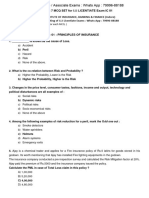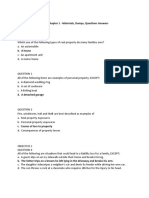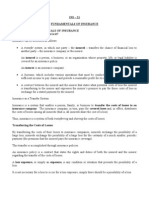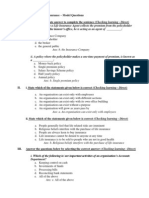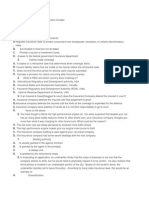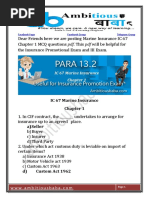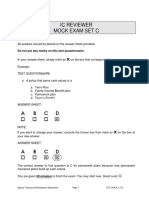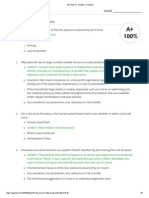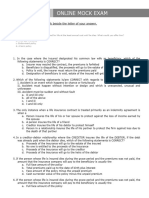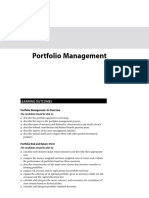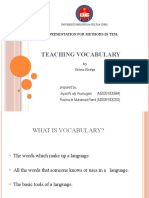OTL Exam E Answer Key New
OTL Exam E Answer Key New
Uploaded by
patrick MuyayaCopyright:
Available Formats
OTL Exam E Answer Key New
OTL Exam E Answer Key New
Uploaded by
patrick MuyayaCopyright
Available Formats
Share this document
Did you find this document useful?
Is this content inappropriate?
Copyright:
Available Formats
OTL Exam E Answer Key New
OTL Exam E Answer Key New
Uploaded by
patrick MuyayaCopyright:
Available Formats
OTL Exam E Answer Key
1. Which of the following is an important requirement for many licensed insurance
professionals to renew their licenses?
a) Attend at least five (5) insurance-related seminars every quarter
b) Complete Adjuster’s Training
c) Complete the Chartered Insurance Professionals (CIP) designation
d) Complete the required number of Continuing Education (CE) hours
2. What does the Statutory Condition—Replacement require when an insurer chooses to repair,
rebuild, or replace property following a loss?
a) Work must commence as soon as practicable
b) Insurer must notify the insured within seven days giving reasons for its decision
c) Insured is no longer required to prove the amount of loss and is therefore not required to
provide proof of loss
d) Insurer must restore the property to its original state even if the cost is in excess of the
amount of insurance
3. Which part of an insurance policy states the perils insured against?
a) Preamble definitions
b) Authority clause
c) Statutory conditions/Quebec General conditions
d) Insuring agreements
4. With respect to the Québec General Condition relating to subrogation, which one (1) of these
statements is TRUE
a) Insurers have subrogation rights against all third parties
b) Insurers have the right to subrogate from third parties for losses paid, except from members
of insureds’ household
c) Insurers have subrogation rights against members of the insured’s household
d) Insurers have subrogation rights against other insurers but not other third parties
5. What kind of offer is needed in order to establish a legally binding contract?
a) The offer must be made and accepted
b) The offer must be witnessed and signed by a lawyer
c) The offer must be written, rather than oral
d) The offer must be for a specific amount of money
6. The Civil Code of Québec has specific sections relating to the same subject matter as the
Statutory Conditions in common law provinces that must be included in all fire, as well as
other types of policies. However, it does NOT determine which of the following?
a) Which items must be dealt with
b) Exact wording to be used
c) How each item must be dealt with
d) Policy cancellation requirements
RBC Learning and Development
7. What is the term used to describe when a broker or agent can accept a risk without first
sending the application to the insurer for approval?
a) Binding authority
b) Utmost good faith
c) Material change in risk
d) Confirmation ability
8. What can be a consequence of the applicant misrepresenting material facts on the
application for insurance?
a) The applicant could be charged with criminal fraud
b) A premium penalty could be charged
c) The loss could be denied or the insurance policy could be voided
d) The broker could be charged a penalty fee by the insurer
9. A single homeowner dies. Her WILL indicates that her home should be left for her adult son.
The insurance policy in this case would receive automatic consent under which of the
following policy Statutory Conditions?
a) Change of interest
b) Property of others
c) Material change
d) Notice
10. Personal line property insurance may be written on a replacement cost basis which is:
a) Same as actual cash value replacement.
b) Replacement or repair of the damaged property as it cost at the time of the loss with property of
like kind and quality, with a deduction for depreciation.
c) Same as B above, without deduction for depreciation.
d) Is not an endorsement.
11. Under the Homeowner’s policy in regards to exclusions, which statement is CORRECT?
a) Accidental fire damage resulting from the application of heat is excluded.
b) Loss, destruction or damage to goods undergoing the process involving the application of heat
is excluded.
c) If the building insured has been vacant or unoccupied for the last twenty- five (25) days loss is
excluded.
d) All of the above are excluded.
12. The Basic Homeowner policy covers:
a) Building, personal property, summer cottage.
b) Building, detached private structures, additional living expenses.
c) Building, legal liability, increased personal property.
d) Building, personal property and fine arts endorsements.
13. Your parents have given you a very old and expensive painting, it should be covered under:
a) Schedules Article endorsement.
b) Under Additional coverage of your Homeowner’s policy.
2
RBC Learning and Development
c) Fine arts endorsement.
d) Under personal property of the policy.
14. The term “Insuring Agreement” in a Fire policy:
a) Refers to the inception and expiry dates of the coverage.
b) Is quite complex and hard to follow.
c) States the risks that are insured.
d) Is the same as the “Declarations” in an auto policy.
15. Sewer Backup Endorsement:
a) Is part of the Home Insurance Policy.
b) Does not generate additional premium.
c) Insured can purchase this endorsement for coverage for loss due to backing of sewer drains.
d) Includes coverage for Increased Cost-Demolition or Construction.
16. The “All Risks” policy:
a) Applies when every kind of loss or damage is covered.
b) Is basically the same as a fire policy with EC.
c) Has exclusions stated in the policy.
d) Covers the same risks as the Named perils policy.
17. Special limitations are not applied if the loss is caused by a specified peril on a Homeowner’s
policy to:
a) Computers, jewelry, silverware.
b) Jewelry, silverware, electrical appliances.
c) Coins and stamp collections.
d) Jewelry, furs, silverware, computer software, stamp and coin collections.
18. Under the Water Escape, Rupture Freezing peril which statement is NOT TRUE?
a) Accidental discharge or overflow or water or steam from within a plumbing, heating or sprinkler
system is covered (includes waterbeds and fish tanks).
b) Sudden and accidental bursting, tearing apart, cracking, burning or bulging due to the pressure
of water or steam is covered.
c) Freezing of any part of a plumbing, heating, sprinkler, air conditioning system or domestic
appliance is covered.
d) Damage caused by continuous or repeated seepage or leakage is covered.
19. Which is NOT considered an insured peril?
a) Impact by aircraft or land vehicle.
b) Smoke.
c) War
d) Water escape, rupture, freezing
20. Watercraft under a Home policy:
3
RBC Learning and Development
a) Includes boats of all sizes.
b) Covers claims arising out of the ownership, use or operation of watercraft up to a specified
size or horsepower.
c) Coverage for Watercraft is not included under a home policy and has to be purchased
separately.
d) Coverage includes watercraft use for business purposes.
21. The insured’s dining room furniture was badly damaged when a fire broke out.
The claim was settled by paying an amount equal to the replacement cost minus physical
depreciation. This illustrates the application of:
a) Extended coverage.
b) Actual Cash Value.
c) Replacement Cost.
d) Optional Loss Settlement.
22. Not all property of the insured is automatically covered under the Homeowner’s All Risk
policy. Which of the following is NOT TRUE?
a) Windstorm damage to the tool shed (detached) is covered.
b) Smoke damage to the drapes following a kitchen fire is covered.
c) Fire damage to the insured’s seasonal residence is covered.
d) Two weeks hotel expenses for the insured while the house is repaired; following collapse of
the roof due to ice is covered.
23. Condominium insurance, which of the following is CORRECT?
a) The Condo unit package does not insure contents.
b) The Condo unit owner must buy insurance for their part of the building’s common elements.
c) The Condo Corporation does not own the land where the building is located.
d) The Condo unit owner owns the space inside the unit, the contents and improvements by the
owner.
24. Which of the following statements is CORRECT in connection with Comprehensive
Homeowner’s insurance?
a) The policy can extend to include personal property of a student insured under the policy that
is temporarily living away from home to attend university.
b) Special limits of insurance do not apply to a Comprehensive Home Owners Policy.
c) Expenses incurred while the client is in the process of renovating their 30 year old home.
d) Detached Private Structures is an optional coverage that can be purchased under a
Comprehensive Homeowners Policy.
25. Under the Entry, Control, Abandonment, the insurer is not entitled to:
a) Enter to survey damage without the consent of the insured.
b) The control or possession of the property.
c) Enter property after it has been secured.
d) Right of access to make appraisement.
RBC Learning and Development
26. The Basic Home Insurance Policy will cover losses caused by?
a) Falling Objects.
b) Riot.
c) Electric current damage due to electrical appliances.
d) All of the Above.
27. Which of the following is required by law in a Fire policy?
a) Extended coverage endorsement.
b) Statutory conditions.
c) A wording.
d) Basic fire policy.
28. Personal Liability Coverage under a Basic Home Insurance Policy:
a) Extends to provide 30-day automatic coverage for a newly acquired principal residence.
b) Does not cover land in Canada that will be occupied by the insured.
c) For more than 90 days.
d) All of the Above.
29. Which of the following clauses or endorsements would have to be attached to a policy, if loss
settlement is to be made without deduction for depreciation?
a) Rebuilding clause.
b) Extended coverage endorsement.
c) Loss clause.
d) Replacement cost.
30. In which of the following is there no special limit with regard to theft?
a) Jewellery, watches and furs
b) Coins
c) Computer hardware
d) Bicycle
31. Which policy has the most similarities with regards to coverage to a Mobile Home policy?
a) Farm policy
b) Tenants policy
c) Homeowner’s policy
d) Condominium owner’s policy
32. The roof of a condominium is damaged by an insured peril. The building’s policy does not
cover the full amount of the loss. To cover such a situation, a unit owner should have:
a) Additional living expense coverage
b) Off premises coverage
c) Condominium unit owner’s additional protection insurance
d) Extended liability coverage
RBC Learning and Development
33. Your client has recently purchased a condominium town house with a fully finished
basement.
Which coverage below would ensure the client is protected? -
a) Loss assessment
b) Unit owner’s contingent insurance
c) Replacement cost endorsement
d) Betterments and improvements
34. A fourteen-year-old child intentionally breaks his friend’s bike. His parents have a
homeowner’s package. Under which section would this be covered?
a) Additional living expenses
b) Property damage section
c) Liability section
d) None of the above
35. A house worth $300,000 is insured for $200,000. There is a $100,000 loss. The policy has
an 80% co-insurance clause. What amount would the insured receive?
a) $83,333
b) $100,000
c) $16,667
d) $70,000
36. Under an All Risk Policy, the factor (s) that really determine the extent of coverage is (are):
a) The All Risk feature
b) The exclusions
c) The insuring agreement
d) The application
37. What is the purpose of the anti-concurrent causation clause?
a. To increase limits should more than one water damage peril occur within a year.
b. To limit coverage should more than one water damage peril occur simultaneously.
c. To decrease limits should more than one water damage peril occur within a year?
d. To add coverage should more than one water damage peril occur simultaneously
38. Which of the following is not covered under the liability section of a Homeowner’s policy
a) A visitor to the insured’s house trips on a loose rug and breaks his leg
b) The insured miss-hits a golf ball and injures someone
c) The insured picks up a hot pot from the stove, badly scalding herself; as a result, time is lost
from work
d) The insured lights a bonfire in his garden. The fire gets out of control and burns a neighbor’s
fence
RBC Learning and Development
39. Mrs. Roe bought a coffee maker, which, due to a manufacturer’s defect caused severe fire
damage to her kitchen. Mrs. Roe sued the manufacturer. Which policy would protect the
manufacturer?
a) Products and Completed Operations
b) Contractual Liability
c) Premises and Operations
d) Owners’ and Contractors’ Protective Liability
40. Two young men were arrested and jailed for a crime they did not commit. The officers would
be protected under:
a) Bodily injury and Property Damage Liability
b) Tenant’s Legal Liability
c) Errors, Omissions and Malpractice
d) Personal Injury Liability
41. Jack hired an electrician to install light fixtures in his home. The electrician fractured his wrist
when a chair slipped out from under him. He is not eligible for Worker’s compensation. He is
not suing. The employee could receive payment under:
a) Employer’s liability
b) Personal liability
c) Voluntary Medical Payments
d) Bodily injury liability
42. Medical payments made under Liability:
a) Are made without regard to fault for bodily injury arising out of an accident subject to
exclusions
b) Are made with no exclusions when bodily injury occurs
c) Are not paid unless negligence is proven
d) Are paid without question or delay
43. An Umbrella policy
a) Covers the self-insured retention
b) Is purchased to avoid gaps in insurance
c) Is purchased when a high limit is needed on only one specific type of coverage
d) Usually provides very limited territorial coverage
44. Which is of the following statements about a Farmer’s Liability policy is false?
a) Premises liability coverage applies only to premises specified in the policy.
b) The liability section of the policy differs from the Homeowner’s form in that it is split into two
parts
c) Liability arising out of the farm premises, farming activities and products liability are covered on
the same policy
d) Separate liability policies are required for the farm and the residence.
45. Which of the following is INCORRECT with respect to business insurance:
7
RBC Learning and Development
a) Is used to underwrite buildings and contents.
b) Also known as Commercial lines insurance.
c) Available to a business owner to protect against losses and to insure the continuing operation of
the business.
d) Does not include Life, Accident and Sickness.
46. Which policy would best suit the needs of accountants and real estate agents?
a) Office Equipment Floater.
b) Commercial Property Floater.
c) Commercial Building and Stock.
d) Small Retail Business Package.
47. A surety bond :
a) Is a contract between two parties
b) Is normally issued for one year
c) Requires two signatures under seal
d) Protects the principal
48. Which is NOT part of the Equipment Breakdown policy?
a) Covers Boilers and Pressure vessels.
b) Covers machinery if an accident does occur.
c) The major peril when insuring boilers and pressure vessels is breakdown.
d) An example of machinery would be electric motors.
49. Which best describes an Extra Expense form?
a) A reduced operation for a period of time.
b) Insures loss of income and profit.
c) This is not an extension of Business Interruption insurance.
d) None of the above.
50. The type and extent of the business activities that Underwriters accept as part of the
Homeowner’s insurance depends on which of the following?
a) Nature of the business conducted on the premises
b) Individual insurer’s underwriting guidelines
c) Both (a) & (b)
d) None of the above
51. Business Interruption insurance is defined as, under the Profit Form:
a) Until the damaged property has been restored and business reopens.
b) For as long as the business results are affected by the interruption, subject to 100% co-
insurance.
c) Same as B above, except 80% co-insurance.
d) It only applies to manufacturing businesses.
52. Extra Expense Form under RBC is designed to:
a) Insure loss of income and profit.
8
RBC Learning and Development
b) Keep business going in spite of a major loss.
c) Proves additional income for employees during a loss.
d) Generally written to 100% co-insurance.
53. Which of the following perils can be insured under a cyber risk policy?
a) Theft of data resulting in a privacy breach
b) Unintentional transmission of a computer virus
c) Network systems that become unavailable due to failure in security
d) All of the above
54. Which of the following statements applies to a Commercial Property Form?
a) No coverage for burglary, but insures property in the custody of salesmen.
b) It is a Named Perils policy.
c) Covers unspecified premises but not newly acquired.
d) Covers stock, equipment,buildings and contents .
55. Which of the following exclusions apply to Glass insurance?
a) Windstorm, war, fire.
b) Fire, windstorm, nuclear damage.
c) Fire, war, nuclear damage.
d) Fire, smoke, nuclear damage.
56. Which of the following items is NOT automatically covered in the 3-D policy?
a) Fidelity
b) Wrongful abstraction of securities outside premises.
c) Forgery or money orders.
d) Sample being shipped from France.
57. Which of the following statements applies to a Surety Bond?
a) Protection is for the benefit of the principal.
b) Either the insurance company or the obligee may cancel at any time.
c) The obligee is that party which is the insured under a contract of insurance.
d) When the Surety pays a claim, it then has the right to recover from the principal.
58. A contractor has been given a Performance Bond, but is now unable to complete the
contract because of bankruptcy. Therefore the Surety will do which of the following?
a) Sue the contractor for breach of contract.
b) Indemnify the principal for any losses suffered.
c) Make arrangements with the obligee to complete the job.
d) Take over the contractors business as trustee.
59. Produce does not include which of the following?
a) Fertilizers
b) Growing crops
c) Packaging
d) Wrapping
9
RBC Learning and Development
60. Which is true as it applies to Occurrence Basis Property damage?
a) Covers damage happening gradually over a period of time.
b) Pollution is covered only if sudden and accidental.
c) It insures the unexpected result of a deliberate act.
d) It covers acts done by the insured with the intent to cause damage.
61. Dr. Smith’s office is damaged in a fire. He is, however, able to continue his practice at
another location, as he has purchased:
a) A Profits form policy
b) A fire policy
c) Extra Expense Insurance
d) Gross Earnings Policy
62. What kind of bond does an executor of wills require?
a) Performance bond
b) Bid bond
c) Fiduciary bond
d) Fidelity bond
63. An importer who receives goods from abroad or sends them overseas, will usually need :
a) Inland Transportation insurance
b) Transportation floater
c) Trip transit
d) Customs or Excise Bonds
64. Which of the following is not taken into consideration when rating for Glass Insurance?
a) Geographical location
b) Whether fixed or movable
c) Height of lowest edge from the ground
d) Fire protection
65. For insurance purposes in Ontario, is a snowmobile considered an automobile? 9i
a) No, because it does not have a license plate
b) Yes, but only when being operated on a public highway
c) Yes, because it does have a license plate
d) No, if it is being operated by an underage driver
66. How is the Income Replacement Benefit under the OAP 1 Owners Policy calculated?
a) 80% of net income, to a maximum of $400
b) 80% of gross income, to a maximum of $500
c) 70% of net income, to a maximum of $500
d) 70% of gross income, to a maximum of $400
10
RBC Learning and Development
67. A garage door is damaged when a car accidentally drives into it. The car also has some
damage. Both the home and car are owned by the driver of the vehicle. What damage will be
covered by the Own Damage coverage of the automobile policy?
a) Damage to both the car and the garage door will be covered
b) No damage will be covered
c) Damage to the car will be covered
d) Damage to the garage door will be covered
68. An insured with an existing OAP 1 Owners Policy purchases a snowmobile and advises the
insurance professional that his 14-year-old son will also operate the vehicle. What should the
insurance professional recommend to ensure there is coverage?
a) There will only be coverage for the physical damage to the snowmobile if the son is operating it.
b) Add OPCF 32—Recreational Vehicle Endorsement, to provide coverage for the underage
operator.
c) There is no coverage while the son is driving as he is under 16 years of age and the coverage
cannot be obtained.
d) Add OPCF 44R—Family Protection Endorsement, to cover any accident the son may have.
69. The Facility Association (FA) can be described as which of the following?
a) A group of insurance carriers that write the insurance risks on automobiles owned by their
agents/brokers and their staff.
b) A reinsurance device for accommodating automobile policyholders who wish to have
particularly high limits of insurance.
c) An insurance pool subscribed to by all automobile insurance carriers that share the writing of
risks not ordinarily written in the regular market.
d) The provincial government insurance office charged with the responsibility of accepting
applications from all automobile owners who cannot get insurance anywhere.
70. What is the purpose of the Facility Association (FA)?
a) Act as a not-for-profit association to develop and maintain driver education facilities
b) Ensure availability of automobile insurance for owners and operators who may otherwise have
difficulty obtaining it
c) Provide a level of cover for policyholder and claimants
d) Negotiate fair wordings for all automobile insurers and act as a lobbyist with the federal
government
71. Which of the following statements about the OAP 1 Owners Policy Direct Compensation—
Property Damage coverage is INCORRECT?
a) The policy on the other vehicle must be issued by an Ontario licensed insurer or one that has
filed with the Ontario Insurance Commission to provide this coverage.
b) The insured collects from her insurer even though the operator of the vehicle, with the insured’s
consent, was not entirely at fault for the accident.
c) The accident may occur anywhere in Canada and at least one of the other automobiles
involved is insured under a motor vehicle liability policy.
11
RBC Learning and Development
d) It covers damage to the automobile, certain unscheduled trailers, their equipment, and contents
caused by another automobile in Ontario, including their loss of use.
72. Which of the following policies is required for a driver that leases a vehicle?
a) OAP 1 Owners Policy, suitably endorsed
b) OPF 2 Driver’s Policy
c) OPF 6 Non-owned Automobile Policy, suitable endorsed
d) OAP 4 Garage Auto Policy, suitably endorsed
73. Which statement correctly describes how the OAP 1 extends coverage to a newly acquired
Replacement Auto?
a) The Replacement Auto will be provided the same coverage as the described automobile it
replaces if the insurer is notified within 14 days of delivery of the Replacement Auto.
b) The Replacement Auto will be provided the same coverage as the described automobile it
replaces if the insurer is notified within 7 days of delivery of the Replacement Auto.
c) The insurance coverage legally required by law is extended until a new policy is signed.
d) Coverage does not automatically extend to the replacement vehicle and a new policy is
required.
74. The insured, John Smith, is driving Robert Brown’s auto as a temporary substitute and is held
liable for an accident. The innocent third party is awarded $800,000. Smith carries liability
limits of $1,000,000 while Brown carries $500,000 on his insurance. How much does John
Smith’s insurer pay?
a) $0
b) $300,000
c) $500,000
d) $800,000
75. An intoxicated driver causes an accident and damages his vehicle, a second vehicle, and a
telephone pole. Which of the following losses will NOT be covered?
a) Collision damage to his automobile
b) Damage to the telephone pole
c) Damage to the other automobile
d) Medical and surgical expenses required as a result of injuries he sustains
76. The OAP 1 Owners Policy or insurance coverage on a described automobile is considered to
be which one (1) of the following?
a) Excess coverage
b) Primary coverage
c) Secondary coverage
d) Optional coverage
77. After the theft of a vehicle, when does the Loss of Use section begin reimbursement?
a) 24 hours after the theft has been reported to the insurer
b) 24 hours after the theft has been reported to the police
c) 48 hours after the theft has been reported to the insurer or to the police
12
RBC Learning and Development
d) 72 hours after the theft has been reported to the insurer or to the police
78. An 18-year-old enters your office and requests insurance on his new Chevrolet Corvette. You
know that most insurers are not keen on insuring young drivers with powerful automobiles.
Which of the following options is the CORRECT approach?
a) Give him an application for automobile insurance to complete, which you will then submit to
an insurer.
b) Recommend that he register the vehicle in his father’s name, as it’s the only way he can obtain
insurance.
c) Refer him to another broker who writes this class of business.
d) Advise him that none of your insurers will insure him.
79. Which of the following statements about Uninsured Automobile coverage is CORRECT?
a) It must be added by endorsement to the OAP 1 Owners Policy.
b) It only covers bodily injury, but never property damage.
c) It can cover accidental damage to the insured’s automobile, provided the uninsured owner o r
driver of the other automobile is identified.
d) It provides coverage for third parties if the insured causes bodily injury and has breached a
Statutory Condition.
80. As an insurance professional, and to ensure adequate coverage, what advice would you offer
someone who purchases and installs a $5,000 stereo system into her car?
a) Be sure to always lock the car, as there is no coverage if the system is stolen when the car is
unlocked.
b) There is no coverage on the system without an approved security system in the car.
c) No further action is needed. The new system is automatically covered under the OAP 1 Owners
Policy as part of the car.
d) To have her OAP 1 Owners Policy endorsed to cover its full value, she needs to provide you
with a copy of the invoice.
81. In the Additional Agreements of the Insurer, Own Damage, the insurer agrees to waive
subrogation against which one (1) of the following?
a) A neighbour driving the auto with the insured’s consent
b) A neighbour who had care or custody of the auto for repair purposes
c) Anyone, other than the named insured, who has breached any condition of the policy
d) Someone who was storing the auto in a parking garage
82. Section 7—Optional Loss or Damage Coverages of the OAP 1 Owners Policy is usually subject
to a deductible. However, the deductible does NOT apply to loss or damage caused by which
of the following perils?
a) Water
b) Lightning
c) Vandalism
d) Windstorm
83. Who is responsible for approving Ontario’s automobile insurance application form?
13
RBC Learning and Development
a. FSCO/FSRA
b. Federal Department of Insurance
c. The Facility Association
d. The Insurance Act
84. The OPCF 44R—Family Protection Coverage
a) applies to property damage caused by unidentified and uninsured motorists.
b) applies a deductible to injury losses.
c) is part of every Canadian owner’s automobile policy.
d) allows an insured to recover up to the limit of his own policy.
85. Under the OAP 1 Loss of Use Due to Theft section, when does reimbursement end?
a) On the date the repairs or replacement is complete
b) On the date the insurer tenders settlement
c) Either on the date the repairs or replacement is complete, or the date the insurer tenders
settlement, whichever occurs first
d) Both on the date the repairs or replacement is complete and the date the insurer tenders
settlement, as settlement will only be tendered when the repairs or replacement is complete
86. Which of the following statements about provincial Insurance Acts governing automobile
insurance applications is CORRECT?
a) A policy cannot be issued without a completed and signed application form.
b) A policy can be issued without a completed and signed application form, but the insured must
sign a copy of the application within 24 hours.
c) If a policy is issued without a signed application, the insurer can print and indicate in the
signature line “verbal application.”
d) If a policy is issued without a signed application, the insurer must send a true copy of the
application to the insured for a signature
87. Which of the following is the CORRECT way to insure a snowmobile?
a) With an OAP 1 Owners Policy to cover all the exposures to be insured
b) By an endorsement to a Homeowners or Tenants Policy to cover the Third Party Liability and a
Personal Articles Floater for direct damage to the machine
c) With an OAP 1 Owners Policy to cover Third Party Liability and Accident Benefits, and an Inland
Marine Floater for direct damage to the machine
d) With a Snowmobile Floater to cover all the exposures to be insured
88. Which of the following statements about lawsuits related to automobile accidents in Ontario
is FALSE?
a) Permitted with respect to economic loss under certain circumstances
b) Not permitted with respect to non-economic loss unless the threshold has been met
c) Not permitted with respect to most health care expenses
d) Not permitted with respect to catastrophic impairment
89. A vehicle is broken into and thieves steal various items. A Specified Perils policy will cover
which one (1) of the following items?
14
RBC Learning and Development
a) Musical instruments that were in the trunk
b) The bumper jack belonging to the automobile
c) The insured’s raincoat
d) Property of the insured’s passengers
90. Which of the following is a FALSE statement about recreational vehicles
a) Coverage under an automobile insurance policy should be excluded by endorsement if an all-
terrain vehicle is used in the water.
b) Not all drivers of recreational vehicles must be licensed.
c) Recreational vehicles are permitted to cross highways.
d) Motorized snow vehicles are automatically covered under an automobile insurance policy; no
endorsements are needed at any time.
91. Sandra, a pedestrian, is seriously injured by a hit-and-run driver who is unidentified. Sandra is
an Ontario resident but is not a licensed driver. Which plan would provide coverage for her
injuries?
a. The Compulsory Automobile Insurance Act will provide the coverage for bodily injuries caused by
unidentified drivers.
b. The facility association provides coverage for bodily injuries caused by high risk drivers.
c. The motor vehicle accident claims funds (MVACFs) provides coverage for bodily injuries caused
by unidentified drivers.
d. The statutory accident benefits provide coverage and will later subrogate against the MVACFs.
92. What maximum amounts will be paid under the priority of payments in Ontario?
a. A maximum of $20,000 for property damage, and a maximum of $180,000 for bodily injury
b. Nothing for the property damage and a maximum of $200,000 for bodily injury
c. A maximum of $10,000 for property damage, and a maximum of $190,000 for bodily inju ry
d. A maximum of $30,000 for property damage, and a maximum of $170,000 for bodily injury
93. What are two disadvantages of the tort system of compensation?
a. There is no appeal process if a party disagrees with the settlement, and parties are not able t o
choose their own lawyers.
b. It is usually adversarial, and the plaintiff lawyer is entitled to a large portion of the settlement.
c. It is usually adversarial, and injured parties often wait years to be compensated .
d. It delays the injured person’s right of recovery, and the courts always favour the uninjured party.
94. Devon was involved in a motor vehicle accident and her antique painting, which was in her
vehicle, was destroyed. Devon was compensated under the DCPD section of her policy. Can
Devon’s insurer subrogate against the at-fault driver for the damaged painting?
a. Yes, subrogation is permitted under the no-fault automobile system for all damaged contents
b. No, compensation for the antique painting must be obtained through her homeowner’s policy
c. Yes, to the degree that Devon was not at fault if the painting was valued in excess of $20,000
d. No, there is no subrogation permitted against insurers under the no-fault automobile system
95. Alan’s roommate takes Alan's car without permission and damages it in an accident. Alan has
Collison and Comprehensive coverages. How will Alan receive assistance to repair his car?
15
RBC Learning and Development
a. Alan has no financial assistance, because his roommate took the car without consent, which is
considered theft, and comprehensive coverage excludes theft by anyone in the insured's
household.
b. Alan will claim for financial assistance under the All Perils section of his insurance policy.
c. Alan will receive financial assistance from the roommate’s insurance policy under the collision
section.
d. Alan will charge his roommate with theft and then it will be covered under the comprehensive
section of his insurance policy.
96. How much notice must an insurer give to an insured when terminating an automobile contract
of insurance that has been in effect for at least 60 days for the reason of non payment of
premium?
a. 5 days by registered mail or 15 days if hand delivered
b. 30 days by registered mail or 10 days if hand delivered
c. 10 days by registered mail or 30 days if hand delivered
d. 15 days by registered mail or 5 days if hand delivered
97. What are the two purposes of the OPCF 27 endorsement?
a. To provide physical damage protection and extend accident benefits coverage to drivers not listed
on the policy
b. To provide legal liability protection for physical damage to a non-owned automobile and to
extend liability insurance to drivers specifically added on this endorsement
c. To provide legal liability protection as well as physical damage protection to a non-owned
automobile
d. To provide accident benefits coverage and legal liability to a non-owned automobile
98. What is NOT a function of the OPCF 6C and 6F Public Transportation?
a. Give coverage for bodily injury to passengers and damage to their property
b. Give the option of a single limit coverage, including passenger hazard and property damage
c. Give permission for the automobile to carry passengers for hire
d. Give permission for the automobile to be used for driver training schools
99. Where are the details of the accident benefits coverages found?
a. Statutory Accident Benefits Schedule
b. Statutory Conditions
c. The Civil Code
d. Highway Traffic Act
100. When are passengers of public transit vehicles eligible to receive statutory accident benefits?
a. When injuries to passengers of the public transit vehicle are serious in nature.
b. When the public transit vehicle driver is convicted of negligence.
c. When two or more public transit vehicles collide with one another.
d. When the public transit vehicle has collided with another automobile or object.
16
RBC Learning and Development
You might also like
- Practise RIBO ExamDocument19 pagesPractise RIBO Examchchnet11186% (7)
- Ghana Electric BillDocument2 pagesGhana Electric Billkassumjesse20No ratings yet
- Basic Insurance Concepts and Principles (5 Edition) Mock PaperDocument9 pagesBasic Insurance Concepts and Principles (5 Edition) Mock PaperAloysius LeeNo ratings yet
- Canadian EthicsDocument8 pagesCanadian EthicsThe StoiC100% (2)
- MCQ Ic 01 Aiibf 350 WM PDF - 211125 - 150804Document63 pagesMCQ Ic 01 Aiibf 350 WM PDF - 211125 - 150804Vijay YerrojuNo ratings yet
- Sample Final Exam For Risk Management and InsuranceDocument6 pagesSample Final Exam For Risk Management and InsuranceJohn KueyNo ratings yet
- INS 22 Chapter 1,2,3,4 With AnswersDocument26 pagesINS 22 Chapter 1,2,3,4 With Answerschinnipvp100% (2)
- Rai Ic - Trad (9426)Document30 pagesRai Ic - Trad (9426)jeffrey resos100% (1)
- BNL Reviewer Exam Answer KeyDocument2 pagesBNL Reviewer Exam Answer KeyKent Mathew BacusNo ratings yet
- MOCK EXAM: Insurance Commission: Module 1 - Principles of Life InsuranceDocument25 pagesMOCK EXAM: Insurance Commission: Module 1 - Principles of Life InsuranceTGiF Travel100% (3)
- Mock Exam Questions WUEDocument37 pagesMock Exam Questions WUEMr. Ahsan Jamal ahsan.jamal50% (2)
- OTL Exam F Answer Key NewDocument15 pagesOTL Exam F Answer Key Newpatrick Muyaya100% (1)
- OTL Exam F Answer Key NewDocument15 pagesOTL Exam F Answer Key Newpatrick Muyaya100% (1)
- C12 Study 4: Anatomy of A Property Policy: Overview: Answer KeyDocument5 pagesC12 Study 4: Anatomy of A Property Policy: Overview: Answer KeyStef CNo ratings yet
- CPCU 520 Mid Term Exam Answer Guide V 2Document9 pagesCPCU 520 Mid Term Exam Answer Guide V 2asdfsdfNo ratings yet
- Insurance QBDocument63 pagesInsurance QBkrishna chaitanyaNo ratings yet
- General Insurance Question Bank-1Document43 pagesGeneral Insurance Question Bank-1samplc2011No ratings yet
- Risk Management and Insurance Solved MCQs Set 3Document7 pagesRisk Management and Insurance Solved MCQs Set 3Gauresh NaikNo ratings yet
- Ins 21 DumpDocument28 pagesIns 21 DumpSourav Dhar100% (2)
- General Insurance INS21Document78 pagesGeneral Insurance INS21geoscribblesNo ratings yet
- Ins 21Document23 pagesIns 21Praveen NayakNo ratings yet
- Ins 21Document88 pagesIns 21SyncmasterKK80% (5)
- Income Taxation Reviewer - San BedaDocument128 pagesIncome Taxation Reviewer - San BedaJennybabe Peta100% (10)
- OTL Exam D Answer KeyDocument15 pagesOTL Exam D Answer Keypatrick MuyayaNo ratings yet
- Chapter 9 Test Risk ManagementDocument18 pagesChapter 9 Test Risk ManagementEymard Siojo0% (1)
- TRad 2 - Print - QuizizzDocument25 pagesTRad 2 - Print - QuizizzJoelyca Sescon100% (2)
- Insurance Exam Text B.CDocument18 pagesInsurance Exam Text B.Cbdndj100% (1)
- OTL Exam A Answer Key New CohortDocument16 pagesOTL Exam A Answer Key New CohorthavelimajevadiNo ratings yet
- Insurance MC QuestionsDocument22 pagesInsurance MC Questionsvyhgvuulj100% (3)
- Mock Test AnswersDocument19 pagesMock Test Answerstoll_meNo ratings yet
- Ans: B. The Insurance CompanyDocument3 pagesAns: B. The Insurance Companyved100% (1)
- INS21 - Q N ADocument28 pagesINS21 - Q N AMiniP.Kumar100% (1)
- Mock Test - 1-1473080346944 PDFDocument7 pagesMock Test - 1-1473080346944 PDFSonali Dulwani100% (1)
- Mock TestDocument11 pagesMock TestSnehil SinghNo ratings yet
- Principles of Insurance (Chapter - Unit 2) Solved MCQs (Set-1)Document5 pagesPrinciples of Insurance (Chapter - Unit 2) Solved MCQs (Set-1)ANURAGNo ratings yet
- LIC-IRDA Exam-1Document10 pagesLIC-IRDA Exam-1umesh50% (2)
- IC-33 Model QuestionsDocument80 pagesIC-33 Model Questionsbhaskardoley30385215No ratings yet
- INS 21 QuestionsDocument9 pagesINS 21 QuestionskillerproNo ratings yet
- IC 67 Marine Insurance PDFDocument8 pagesIC 67 Marine Insurance PDFAmi Mehta67% (3)
- Ic Mock Exam Set C PDFDocument11 pagesIc Mock Exam Set C PDFHerson LaxamanaNo ratings yet
- Property and Liability Insurance MCQDocument4 pagesProperty and Liability Insurance MCQmib_santosh100% (3)
- Test - INS 21 - Chapter - QuizletDocument8 pagesTest - INS 21 - Chapter - QuizletHuma0% (1)
- Online+trad.+ic+mock+exam 09262023Document9 pagesOnline+trad.+ic+mock+exam 09262023Sonny CandidoNo ratings yet
- Reviewer 1Document24 pagesReviewer 1Alron Dela Victoria AncogNo ratings yet
- AGI Exam 1 With Answers - EnglishDocument13 pagesAGI Exam 1 With Answers - EnglishBaskar SayeeNo ratings yet
- SAMPLE EXAM 1aDocument12 pagesSAMPLE EXAM 1abasquesheep71% (7)
- Ic Trad Life Mock Exam 1Document9 pagesIc Trad Life Mock Exam 1Cris Rivera75% (4)
- Chapter 1 Question AnswersDocument5 pagesChapter 1 Question AnswersRoshan JaiswalNo ratings yet
- Mock Exam - Set 4: Compiled by FSA As at April 2008Document14 pagesMock Exam - Set 4: Compiled by FSA As at April 2008Farah S Noshirwani67% (3)
- CPCU 520 Chapter 5 Risk Control and Premium Auditing Session QuizDocument2 pagesCPCU 520 Chapter 5 Risk Control and Premium Auditing Session QuizasdfsdfNo ratings yet
- MCQ Re-InsuranceDocument1 pageMCQ Re-InsuranceAMIT BHATIA100% (3)
- QUESTION One (Multiple Choice) : Insurance Company OperationsDocument14 pagesQUESTION One (Multiple Choice) : Insurance Company Operationsmamush fikaduNo ratings yet
- ReInsurance Question BankDocument9 pagesReInsurance Question Bankkarthick.kanagarajNo ratings yet
- Insurance Commission Reviewer Set ADocument9 pagesInsurance Commission Reviewer Set AMelissa CaagNo ratings yet
- Rnis College of Insurance: New Ic 33 - Model Test 4Document6 pagesRnis College of Insurance: New Ic 33 - Model Test 4Raj Kumar DepalliNo ratings yet
- Shruti OTL 2Document38 pagesShruti OTL 2arshbrar16No ratings yet
- Fire and Engineering Questions 04102008Document24 pagesFire and Engineering Questions 04102008suri91No ratings yet
- PracticeDocument23 pagesPracticedarpalNo ratings yet
- AINS 22 - Segment B Quiz (Qizlet)Document18 pagesAINS 22 - Segment B Quiz (Qizlet)Karly Alleyne100% (1)
- ABBREVIATIONSDocument74 pagesABBREVIATIONSElizabeth SharmaNo ratings yet
- All Deptt Question Bank 72Document181 pagesAll Deptt Question Bank 72rjayanic1No ratings yet
- Fire 9Document8 pagesFire 9nia.713303No ratings yet
- TRAD (IIAP) - Mock 1 PDFDocument7 pagesTRAD (IIAP) - Mock 1 PDFivelisseraelle13No ratings yet
- ( (Title) ) ( (Forename) ) ( (Surname) ) ( (Caller'S Name) )Document7 pages( (Title) ) ( (Forename) ) ( (Surname) ) ( (Caller'S Name) )patrick MuyayaNo ratings yet
- Portfolio Management: Learning OutcomesDocument3 pagesPortfolio Management: Learning Outcomespatrick MuyayaNo ratings yet
- CFA, Ethical and ProfessionalDocument2 pagesCFA, Ethical and Professionalpatrick MuyayaNo ratings yet
- An Analytical Study of The Effect of InfDocument17 pagesAn Analytical Study of The Effect of Infpatrick MuyayaNo ratings yet
- ChatgptDocument1 pageChatgptpatrick MuyayaNo ratings yet
- Chapter 1 - Overview of Cost & Mgt. AcctDocument72 pagesChapter 1 - Overview of Cost & Mgt. AcctYonas BamlakuNo ratings yet
- Suppliers GST Details (CA Nitesh Ji) - MarchDocument5 pagesSuppliers GST Details (CA Nitesh Ji) - MarchMd SaiefNo ratings yet
- Ineffective, Immoral, Politically Convenient: America's Overreliance On Economic Sanctions and What To Do About ItDocument20 pagesIneffective, Immoral, Politically Convenient: America's Overreliance On Economic Sanctions and What To Do About ItCato InstituteNo ratings yet
- Z 4Document9 pagesZ 4Helios HexNo ratings yet
- Working at NightDocument280 pagesWorking at NightArjun YadavNo ratings yet
- Ramon Ching and Po Wing Corp. v. Rodriguez, Et Al., G.R. No. 192828Document5 pagesRamon Ching and Po Wing Corp. v. Rodriguez, Et Al., G.R. No. 192828MhaliNo ratings yet
- AWS APA Annotated Bibliography SAMPLEDocument3 pagesAWS APA Annotated Bibliography SAMPLESlittNo ratings yet
- Case Digest, Travel-On Vs Court of Appeals, 1992Document2 pagesCase Digest, Travel-On Vs Court of Appeals, 1992Jesa FormaranNo ratings yet
- Book 2018 Contemporary Security StudiesDocument244 pagesBook 2018 Contemporary Security StudiesՆարեկ Ս. ԳալստյանNo ratings yet
- Case Digests Law 1-Law On Obligations & Contracts I. Title: Inchausti vs. Yulo G.R. No. L-7721 II. PartiesDocument3 pagesCase Digests Law 1-Law On Obligations & Contracts I. Title: Inchausti vs. Yulo G.R. No. L-7721 II. PartiesAiemiel ZyrraneNo ratings yet
- Onnapattu v5.0Document2 pagesOnnapattu v5.0xposantseNo ratings yet
- E-Way Bill SystemDocument2 pagesE-Way Bill Systemashokdwrk901No ratings yet
- Comparison of Economic System Between Indonesia and SwedenDocument2 pagesComparison of Economic System Between Indonesia and SwedenSyaida NafisaNo ratings yet
- Affidavit of Laurence Schneider in Support of Temporary Restraining Order (16-009292 537) D.E. 582Document34 pagesAffidavit of Laurence Schneider in Support of Temporary Restraining Order (16-009292 537) D.E. 582lschneider68No ratings yet
- Political Science PGDocument47 pagesPolitical Science PGGaurav NewareNo ratings yet
- Sem 7 - Criminilogy Law Project - Juvenile Justice Bill, 2014Document35 pagesSem 7 - Criminilogy Law Project - Juvenile Justice Bill, 2014Anonymous KRQaT2PnYqNo ratings yet
- Didm CPNP Guidance May 26, 2021 With Hyperlinked Updates v2Document10 pagesDidm CPNP Guidance May 26, 2021 With Hyperlinked Updates v2CRS OFFICE REPORTSNo ratings yet
- Tia 130 20 3Document1 pageTia 130 20 3Saurabh ChaddhaNo ratings yet
- Maloga v. Gella PDFDocument2 pagesMaloga v. Gella PDFjagabriel616No ratings yet
- Jason Huynh: Unit: Introduction Lesson: Course IntroductionDocument7 pagesJason Huynh: Unit: Introduction Lesson: Course IntroductionJASON HUYNHNo ratings yet
- FPJ International Epaper-23!08!2023Document22 pagesFPJ International Epaper-23!08!2023sagart817296No ratings yet
- Fa 66Document7 pagesFa 66shreya yadavNo ratings yet
- GEC-8 (ContemporaryWorld) Lecture Notes For FinalsDocument15 pagesGEC-8 (ContemporaryWorld) Lecture Notes For FinalsJasmine Nicole OsallaNo ratings yet
- Teaching Vocabulary: Presentation For Methods in TeslDocument19 pagesTeaching Vocabulary: Presentation For Methods in TeslLina Li100% (2)
- Cambodia - Purchase Order Terms and ConditionsDocument2 pagesCambodia - Purchase Order Terms and ConditionsRathak PhokNo ratings yet
- MJL Press Release 6 5 23Document2 pagesMJL Press Release 6 5 23api-672789525No ratings yet
- Notice: Antidumping or Contervailing Duty Order, Finding, or Suspended Investigation: Opportunity To Request Administrative ReviewDocument3 pagesNotice: Antidumping or Contervailing Duty Order, Finding, or Suspended Investigation: Opportunity To Request Administrative ReviewJustia.comNo ratings yet
- TC - K 1 Memorial For Appellant (Final)Document23 pagesTC - K 1 Memorial For Appellant (Final)muzammil shaikhNo ratings yet




